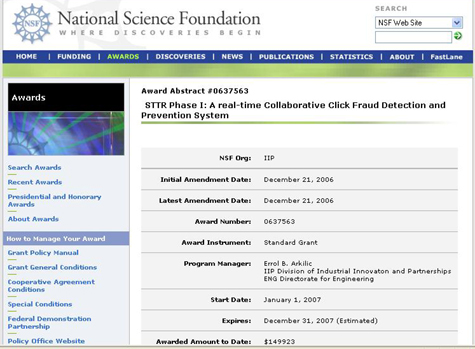Click fraud: $150,000 solution in 2007?

Click fraud has caught the eye of the National Science Foundation.
The Division of Industrial Innovation and Partnerships awarded a one-year grant of $149,923 for development of a “real-time Collaborative Click Fraud Detection and Prevention System,” as part of its Small Business Technology Transfer (STTR) program.

The STTR is a Small Business Administration initiative:
STTR is a highly competitive program that reserves a specific percentage of federal R & D funding for award to small business and nonprofit research institution partners. Small business has long been where innovation and innovators thrive. But the risk and expense of conducting serious R & D efforts can be beyond the means of many small businesses.
Conversely, nonprofit research laboratories are instrumental in developing high-tech innovations. But frequently, innovation is confined to the theoretical, not the practical. STTR combines the strengths of both entities by introducing entrepreneurial skills to high-tech research efforts. The technologies and products are transferred from the laboratory to the marketplace. The small business profits from the commercialization, which, in turn, stimulates the U.S. economy.
The STTR $149,923 grant for development of a “real-time Collaborative Click Fraud Detection and Prevention System” aims to support:
A commercial solution to click fraud identification and prevention. The current existing solutions can not detect the so-called software click. This STTR project proposes a real time collaborative click fraud detection and prevention system to detect these software clicks. The approach draws on data mining techniques for fraud identification using detailed user activities. An accurate and efficient classification method based on association rule mining and data stream mining will be formulated to identify the click frauds.
The Interactive Advertising Bureau believes there should be standardized accounting for clicks and in 2007 will continue its leadership of an Industry-wide Click Measurement Working Group aimed at creating a set of Click Measurement Guidelines: SEE: "Click fraud and Google: As wholesome as milk?" and "Google, Yahoo click fraud audits: When will advertisers demand them?"